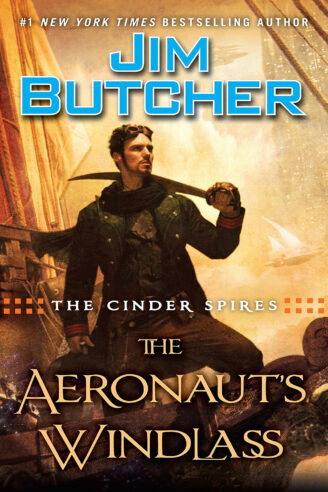The Aeronaut’s Windlass is a hard book to describe. I went into it expecting a steampunk story. That influence is clear, but there is more. Jim Butcher brings elements of high fantasy and naval fiction (albeit transposed into the skies) and perhaps a dash of the post-apocalyptic.
What I can tell you with certainty is that this is an entertaining book.
The world of The Aeronaut’s Windlass (the first volume in the yet-to-be-completed Cinder Spires series) is dominated by massive towers, called spires, in which human beings live. One memorable scene involves a woman seeing the sky for the first time. It is implied that many never do. Something horrible must have happened on the surface, for dangerous creatures will occasionally crawl up the spires through ventilation tunnels.
The central setting is Spire Albion, an old name for Britain. Spire Albion’s government is reminiscent of the United Kingdom, with a large aristocracy governing the country in the name of a constitutional monarch.
Much of The Aeronaut’s Windlass follows the journeys of massive battleships that function like ships from the Age of Sail, or maybe ironclads a few decades later. They fly through the skies, some in military service, some as privateers, some as merchants. Butcher makes what could be rivet-counting slogs into briskly plotted encounters that make you feel as if you are shaking along with the ship when it is bombarded. You can almost hear the thunder of the guns.
Butcher is just as good as describing more intimate combat, which happens with swords or fists or magical crystals that approximate firearms. He skillfully exploits the different environments of Spire Albion to provide a variety of settings for interesting battles to occur. Particularly striking is the use of the previously-mentioned ventilation shafts, which provide a claustrophobia to the proceedings.
Spire Albion’s physical environment is just as interesting as its social setting. There is a thriving culture, proletarian and aristocratic, and characters representing both are present among the chief ensemble.
There is enough religion, which feels vaguely Christian (perhaps a version remembered centuries after an apocalypse?), to provide for the existence of a monastery, in which one of the novel’s most impactful scenes takes place.
Running parallel to human society is a society of intelligent cats, symbiotic but also deeply apprehensive of the humans with whom they work to survive.
Butcher deftly balances a large cast to explore his world and advance his plot; they are military and civilian, rich and poor, male and female. He has a knack for pacing, never allowing one character to dominate at the expense of the others. They form a cohesive whole.
The Aeronaut’s Windlass is a fun book, and an introduction to a series that should be good if they’re anywhere near the quality of this one. With a stew of steampunk and many other influences, it will satisfy any fan of the genre.





